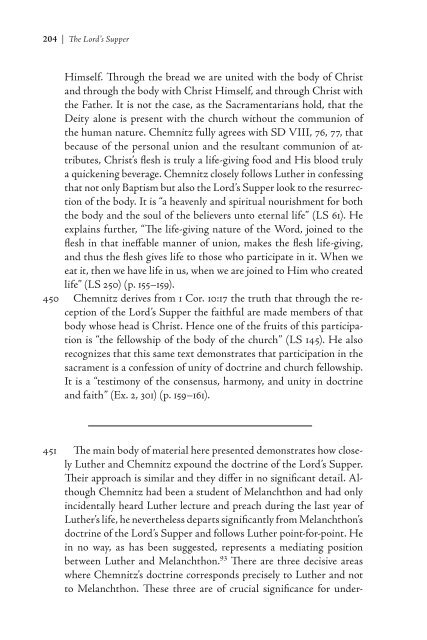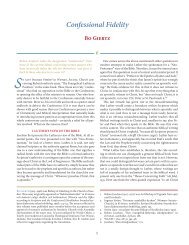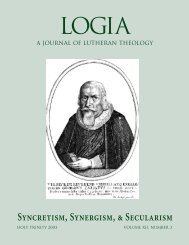The Lord's Supper in the Theology of Martin Chemnitz Bjarne - Logia
The Lord's Supper in the Theology of Martin Chemnitz Bjarne - Logia
The Lord's Supper in the Theology of Martin Chemnitz Bjarne - Logia
Create successful ePaper yourself
Turn your PDF publications into a flip-book with our unique Google optimized e-Paper software.
0 | <strong>The</strong> Lord’s <strong>Supper</strong><br />
Himself. Through <strong>the</strong> bread we are united with <strong>the</strong> body <strong>of</strong> Christ<br />
and through <strong>the</strong> body with Christ Himself, and through Christ with<br />
<strong>the</strong> Fa<strong>the</strong>r. It is not <strong>the</strong> case, as <strong>the</strong> Sacramentarians hold, that <strong>the</strong><br />
Deity alone is present with <strong>the</strong> church without <strong>the</strong> communion <strong>of</strong><br />
<strong>the</strong> human nature. <strong>Chemnitz</strong> fully agrees with SD VIII, 76, 77, that<br />
because <strong>of</strong> <strong>the</strong> personal union and <strong>the</strong> resultant communion <strong>of</strong> attributes,<br />
Christ’s flesh is truly a life-giv<strong>in</strong>g food and His blood truly<br />
a quicken<strong>in</strong>g beverage. <strong>Chemnitz</strong> closely follows Lu<strong>the</strong>r <strong>in</strong> confess<strong>in</strong>g<br />
that not only Baptism but also <strong>the</strong> Lord’s <strong>Supper</strong> look to <strong>the</strong> resurrection<br />
<strong>of</strong> <strong>the</strong> body. It is “a heavenly and spiritual nourishment for both<br />
<strong>the</strong> body and <strong>the</strong> soul <strong>of</strong> <strong>the</strong> believers unto eternal life” (LS 61). He<br />
expla<strong>in</strong>s fur<strong>the</strong>r, “<strong>The</strong> life-giv<strong>in</strong>g nature <strong>of</strong> <strong>the</strong> Word, jo<strong>in</strong>ed to <strong>the</strong><br />
flesh <strong>in</strong> that <strong>in</strong>effable manner <strong>of</strong> union, makes <strong>the</strong> flesh life-giv<strong>in</strong>g,<br />
and thus <strong>the</strong> flesh gives life to those who participate <strong>in</strong> it. When we<br />
eat it, <strong>the</strong>n we have life <strong>in</strong> us, when we are jo<strong>in</strong>ed to Him who created<br />
life” (LS 250) (p. 155–159).<br />
450 <strong>Chemnitz</strong> derives from 1 Cor. 10:17 <strong>the</strong> truth that through <strong>the</strong> reception<br />
<strong>of</strong> <strong>the</strong> Lord’s <strong>Supper</strong> <strong>the</strong> faithful are made members <strong>of</strong> that<br />
body whose head is Christ. Hence one <strong>of</strong> <strong>the</strong> fruits <strong>of</strong> this participation<br />
is “<strong>the</strong> fellowship <strong>of</strong> <strong>the</strong> body <strong>of</strong> <strong>the</strong> church” (LS 145). He also<br />
recognizes that this same text demonstrates that participation <strong>in</strong> <strong>the</strong><br />
sacrament is a confession <strong>of</strong> unity <strong>of</strong> doctr<strong>in</strong>e and church fellowship.<br />
It is a “testimony <strong>of</strong> <strong>the</strong> consensus, harmony, and unity <strong>in</strong> doctr<strong>in</strong>e<br />
and faith” (Ex. 2, 301) (p. 159–161).<br />
451 <strong>The</strong> ma<strong>in</strong> body <strong>of</strong> material here presented demonstrates how closely<br />
Lu<strong>the</strong>r and <strong>Chemnitz</strong> expound <strong>the</strong> doctr<strong>in</strong>e <strong>of</strong> <strong>the</strong> Lord’s <strong>Supper</strong>.<br />
<strong>The</strong>ir approach is similar and <strong>the</strong>y differ <strong>in</strong> no significant detail. Although<br />
<strong>Chemnitz</strong> had been a student <strong>of</strong> Melanchthon and had only<br />
<strong>in</strong>cidentally heard Lu<strong>the</strong>r lecture and preach dur<strong>in</strong>g <strong>the</strong> last year <strong>of</strong><br />
Lu<strong>the</strong>r’s life, he never<strong>the</strong>less departs significantly from Melanchthon’s<br />
doctr<strong>in</strong>e <strong>of</strong> <strong>the</strong> Lord’s <strong>Supper</strong> and follows Lu<strong>the</strong>r po<strong>in</strong>t-for-po<strong>in</strong>t. He<br />
<strong>in</strong> no way, as has been suggested, represents a mediat<strong>in</strong>g position<br />
between Lu<strong>the</strong>r and Melanchthon. 93 <strong>The</strong>re are three decisive areas<br />
where <strong>Chemnitz</strong>’s doctr<strong>in</strong>e corresponds precisely to Lu<strong>the</strong>r and not<br />
to Melanchthon. <strong>The</strong>se three are <strong>of</strong> crucial significance for under-




